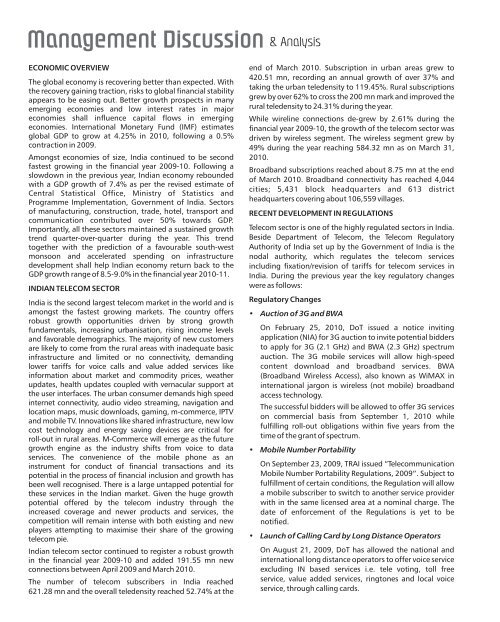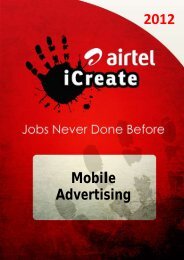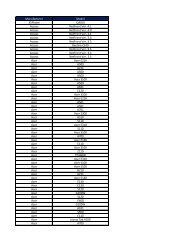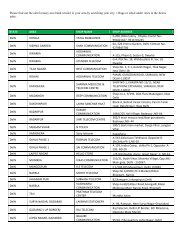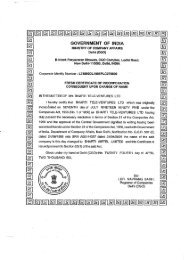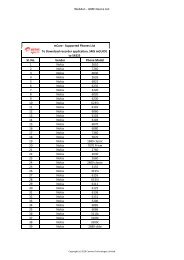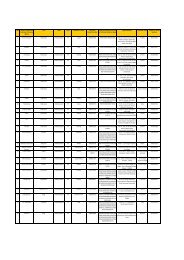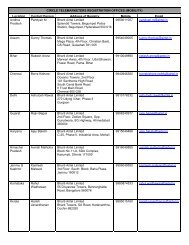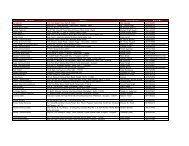You also want an ePaper? Increase the reach of your titles
YUMPU automatically turns print PDFs into web optimized ePapers that Google loves.
ECONOMIC OVERVIEW<br />
The global economy is recovering better than expected. With<br />
the recovery gaining traction, risks to global financial stability<br />
appears to be easing out. Better growth prospects in many<br />
emerging economies and low interest rates in major<br />
economies shall influence capital flows in emerging<br />
economies. International Monetary Fund (IMF) estimates<br />
global GDP to grow at 4.25% in 2010, following a 0.5%<br />
contraction in 2009.<br />
Amongst economies of size, India continued to be second<br />
fastest growing in the financial year 2009-10. Following a<br />
slowdown in the previous year, Indian economy rebounded<br />
with a GDP growth of 7.4% as per the revised estimate of<br />
Central Statistical Office, Ministry of Statistics and<br />
Programme Implementation, Government of India. Sectors<br />
of manufacturing, construction, trade, hotel, transport and<br />
communication contributed over 50% towards GDP.<br />
Importantly, all these sectors maintained a sustained growth<br />
trend quarter-over-quarter during the year. This trend<br />
together with the prediction of a favourable south-west<br />
monsoon and accelerated spending on infrastructure<br />
development shall help Indian economy return back to the<br />
GDP growth range of 8.5-9.0% in the financial year 2010-11.<br />
INDIAN TELECOM SECTOR<br />
India is the second largest telecom market in the world and is<br />
amongst the fastest growing markets. The country offers<br />
robust growth opportunities driven by strong growth<br />
fundamentals, increasing urbanisation, rising income levels<br />
and favorable demographics. The majority of new customers<br />
are likely to come from the rural areas with inadequate basic<br />
infrastructure and limited or no connectivity, demanding<br />
lower tariffs for voice calls and value added services like<br />
information about market and commodity prices, weather<br />
updates, health updates coupled with vernacular support at<br />
the user interfaces. The urban consumer demands high speed<br />
internet connectivity, audio video streaming, navigation and<br />
location maps, music downloads, gaming, m-commerce, IPTV<br />
and mobile TV. Innovations like shared infrastructure, new low<br />
cost technology and energy saving devices are critical for<br />
roll-out in rural areas. M-Commerce will emerge as the future<br />
growth engine as the industry shifts from voice to data<br />
services. The convenience of the mobile phone as an<br />
instrument for conduct of financial transactions and its<br />
potential in the process of financial inclusion and growth has<br />
been well recognised. There is a large untapped potential for<br />
these services in the Indian market. Given the huge growth<br />
potential offered by the telecom industry through the<br />
increased coverage and newer products and services, the<br />
competition will remain intense with both existing and new<br />
players attempting to maximise their share of the growing<br />
telecom pie.<br />
Indian telecom sector continued to register a robust growth<br />
in the financial year 2009-10 and added 191.55 mn new<br />
connections between April 2009 and March 2010.<br />
The number of telecom subscribers in India reached<br />
621.28 mn and the overall teledensity reached 52.74% at the<br />
end of March 2010. Subscription in urban areas grew to<br />
420.51 mn, recording an annual growth of over 37% and<br />
taking the urban teledensity to 119.45%. Rural subscriptions<br />
grew by over 62% to cross the 200 mn mark and improved the<br />
rural teledensity to 24.31% during the year.<br />
While wireline connections de-grew by 2.61% during the<br />
financial year 2009-10, the growth of the telecom sector was<br />
driven by wireless segment. The wireless segment grew by<br />
49% during the year reaching 584.32 mn as on March 31,<br />
2010.<br />
Broadband subscriptions reached about 8.75 mn at the end<br />
of March 2010. Broadband connectivity has reached 4,044<br />
cities; 5,431 block headquarters and 613 district<br />
headquarters covering about 106,559 villages.<br />
RECENT DEVELOPMENT IN REGULATIONS<br />
Telecom sector is one of the highly regulated sectors in India.<br />
Beside Department of Telecom, the Telecom Regulatory<br />
Authority of India set up by the Government of India is the<br />
nodal authority, which regulates the telecom services<br />
including fixation/revision of tariffs for telecom services in<br />
India. During the previous year the key regulatory changes<br />
were as follows:<br />
Regulatory Changes<br />
• Auction of 3G and BWA<br />
On February 25, 2010, DoT issued a notice inviting<br />
application (NIA) for 3G auction to invite potential bidders<br />
to apply for 3G (2.1 GHz) and BWA (2.3 GHz) spectrum<br />
auction. The 3G mobile services will allow high-speed<br />
content download and broadband services. BWA<br />
(Broadband Wireless Access), also known as WiMAX in<br />
international jargon is wireless (not mobile) broadband<br />
access technology.<br />
The successful bidders will be allowed to offer 3G services<br />
on commercial basis from September 1, 2010 while<br />
fulfilling roll-out obligations within five years from the<br />
time of the grant of spectrum.<br />
• Mobile Number Portability<br />
On September 23, 2009, TRAI issued “Telecommunication<br />
Mobile Number Portability Regulations, 2009”. Subject to<br />
fulfillment of certain conditions, the Regulation will allow<br />
a mobile subscriber to switch to another service provider<br />
with in the same licensed area at a nominal charge. The<br />
date of enforcement of the Regulations is yet to be<br />
notified.<br />
• Launch of Calling Card by Long Distance Operators<br />
On August 21, 2009, DoT has allowed the national and<br />
international long distance operators to offer voice service<br />
excluding IN based services i.e. tele voting, toll free<br />
service, value added services, ringtones and local voice<br />
service, through calling cards.


